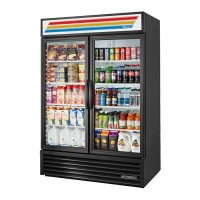106
REFRIGERATION TROUBLESHOOTING CHART
Freezer ...Continued
1. If compressor is running and you have a low amp draw with a high suction pressure and a low head pressure
your compressor has bad valves replace compre s s o r.
2. If you have a low suction pressure and a low head pressure you may have one of a few different things
happening with your system.
A. Kinks in the suction line or compressor pullout.
1. Check for kinks and repair tubing if needed.
B. CRO valve not functioning correctly.
1. Install a line tap in suction line to verify pressure upstream of valve, replace valve if needed.
C. Evaporator or accumulator may be logged with oil.
1. Disconnect termination switch from timer and run system through an extended defrost cycle to
warm oil and get it to return to the compressor after putting back in freeze cycle.
2. Allow evaporator to warm up and remove capillary tube from evaporator then blow nitrogen
through evaporator. You may also want to poke a hole in the accumulator with a scratch awl to add
in the oil removal.
D. You may also have a system that is low on refrigerant charge or have a capillary tube or drier that is
restricting refrigerant flow.
1. Add a few ounces of refrigerant to system.
2. Recover the charge and weigh in the correct amount of refrigerant.
With either of these options used if the pressures rise and the cabinet begins to function correctly we
know that the cabinet was low on charge. This means that there is a leak in the refrigeration system
that now must be located. A technician can raise the system pressure up to 200 psi with nitrogen to aid
in the leak search. Remember that the foam itself will make a leak detector (sniffer type) react.
AFTER LEAK IS LOCATED IT IS VERY IMPORTANT THAT THE SYSTEM DRIER IS
CHANGED AND THAT A 200 MICRON VACUUM IS PULLED THROUGH BOTH THE HIGH
AND LOW SIDE ACCESS FITTINGS.
When leak is located recover refrigerant, at this time the technician may want to remove any line taps they
might have installed and solder on access fittings to pull the vacuum and recharge the system. (After charg i n g
the system both of the access valves must be removed from the system.)
If the head pressure falls right back down after you stop adding refrigerant and the suction pressure stays low
there may be a restriction in the system Recover refrigerant and cut out the drier along with about 1 " of the
capillary tube. Circulate nitrogen through the system to clear any restrictions in the evaporator. Evacuate the
system and recharge.
If the problem still exists the capillary tube may need to be replaced.

